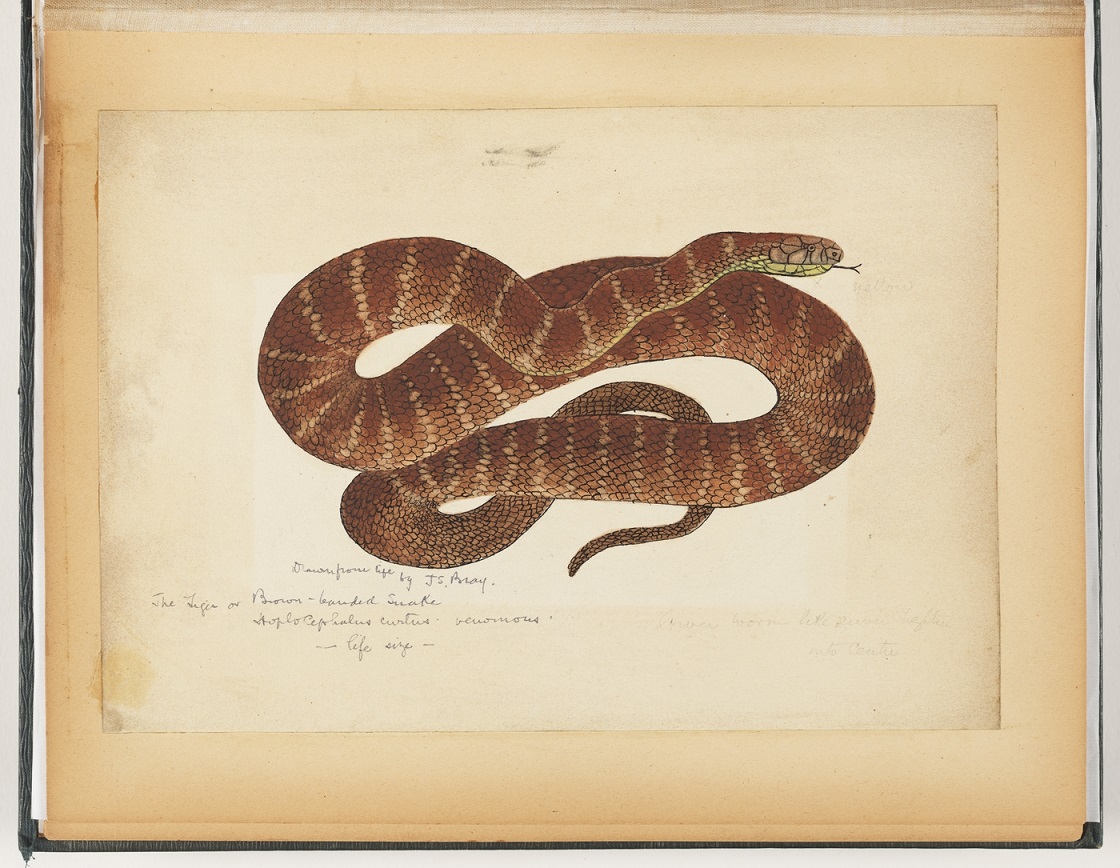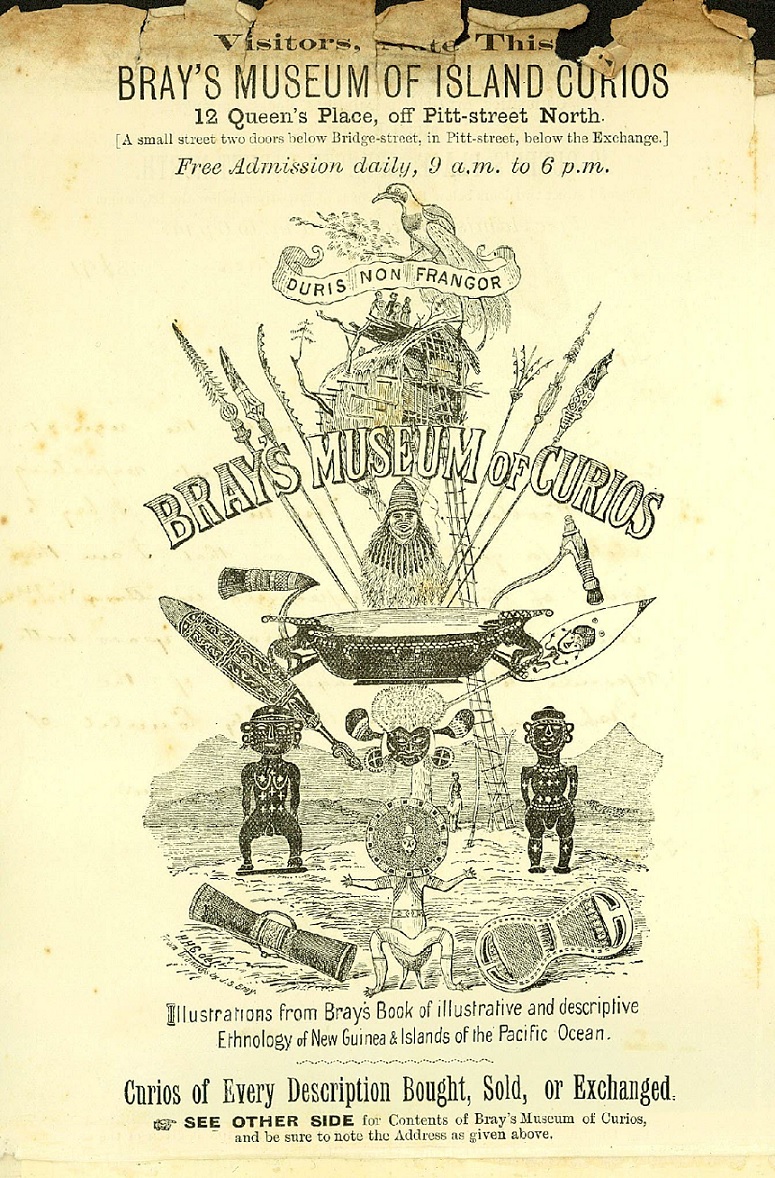The Dictionary of Sydney was archived in 2021.
James Bray and his Museum of Curios
 Drawn from life by JS Bray, the tiger or brown-banded snake, Hoplocephalus curtus - venomous by JS Bray, courtesy Mitchell Library, State Library of NSW (c004220010 / PXA 192)
Drawn from life by JS Bray, the tiger or brown-banded snake, Hoplocephalus curtus - venomous by JS Bray, courtesy Mitchell Library, State Library of NSW (c004220010 / PXA 192)
The first entry to be published on the Dictionary since our recent move to the new platform at the State Library of NSW is a fascinating look by Dr Peter Hobbins at the colourful life and work of James Samuel Bray, a prolific 19th century Sydney naturalist. This week on 2SER Breakfast, Nic spoke to Peter about Bray, his snakes and his museums of curios.
James Samuel Bray was an amateur naturalist in Sydney. He was a quirky chap, one of that string of strange but wonderful personalities that you see throughout the nineteenth century in Sydney, like John MacArthur and Henry Parkes. These men appeared to have extraordinary self confidence and often a blatant disregard of morals of the day, and would seem to press ahead and makes something of themselves. James Bray differed in that he never quite made it or lived up to his own expectations, but he nevertheless had a fascinating life.
 This drawing in Bray's notebooks of condemned convicts leg irons in Brays Museum Sydney 10 August 1891 was accompanied by this information 'The Hon G Thornton who viewed the original specimen of these heavy convict leg irons (only used on convicts when condemned to death in the early times of New South Wales) assured me that he had frequently seen several of the men with such irons on them' Courtesy Mitchell Library, State Library of NSW (PXA 188)
This drawing in Bray's notebooks of condemned convicts leg irons in Brays Museum Sydney 10 August 1891 was accompanied by this information 'The Hon G Thornton who viewed the original specimen of these heavy convict leg irons (only used on convicts when condemned to death in the early times of New South Wales) assured me that he had frequently seen several of the men with such irons on them' Courtesy Mitchell Library, State Library of NSW (PXA 188)
Bray was born in Sydney in 1849 as New South Wales was about to be transformed by the gold rushes. This period saw an enormous growth in population across the 1850s and 1860s and with the spread of suburbs across Sydney, an associated loss of earlier colonial culture and indigenous culture as well as local flora and fauna. His family had moved from the centre of the city to Milsons Point on the harbour's north shore when he was child, an area which at that point was still only partly developed. As a teenager Bray was fascinated not only by the natural history of Sydney, but also the city's indigenous heritage. He would go prowling around the north shore and Manly looking for wildlife (which he was more than happy to kill and stuff), for items of Aboriginal heritage and he became more and more obsessed with relics of Sydney's colonial past.
A talented natural history writer, Bray also created celebrated taxidermy displays for intercolonial exhibitions. He exhibited at Sydney's Garden Palace in 1879, and in 1874 his collection of award winning entomological specimens was displayed in the gallery of the new General Post Office building where he also worked in the Telegraph Office until 1876.
In the early 1880s, Bray established the first of his Museums of Curios, where he would sell the skulls of indigenous people from Australia & the Pacific, carved artefacts from indigenous cultures, taxidermy specimens, convict chains, coins, watercolours and almost anything in the nature of a relic he thought he could turn to account. This business failed quickly, but by the late 1880s he had opened up again near Circular Quay. When this business also failed in 1892, he began trading out of his home at 100 Forbes Woolloomooloo, where he also continued breeding snakes. Rather than just being an entrepreneur, Bray craved scientific respectability but this was never to be. His work, much like his business models, belonged to an earlier time and had fallen out of fashion.
 Flyer for Bray's Museum of Island Curios c1891 Courtesy City of Sydney Archives (26/248/408)
Flyer for Bray's Museum of Island Curios c1891 Courtesy City of Sydney Archives (26/248/408)
His fascination with Sydney's flora, fauna and particularly snakes can be seen in his papers at the State Library where he extensively documents his activities and research. He loved going out into the bush and catching snakes, and describes how he'd go about this. He designed and built a snake house in the backyard of his home in Woolloomooloo, carefully considering how best to keep the snakes in his care warm and safe. He was perhaps more interested in snakes than anybody else in the colony at that time.
Although he never earned the scientific acclaim he craved, and after his death in 1916 was soon forgotten, James Samuel Bray nevertheless embodied a sense of aspiration common to many late-Victorian colonists. If he failed to capitalise on their curiosity, his Museum of Curios captured something of the growing concern that sprawling modernity entailed irredeemable losses of Australia's natural and cultural heritage.
You can read Peter's entry about James Bray and find out more about his life on the Dictionary here https://dictionaryofsydney.org/entry/bray_james_samuel
We're right in the middle of History Week 2017 and there are still so many great events to get to - for the full program and to find out what's on in your local area, go to the History Council of NSW website here. http://historycouncilnsw.org.au/history-week/ Happy History Week!
The Dictionary of Sydney is proud to support History Week 2017 as a Cultural Partner of the History Council of NSW
 Peter Hobbins is an historian of science, technology and medicine at the University of Sydney. Much of his work has explored the meanings and boundaries of 'scientific medicine', in both nineteenth- and twentieth-century Australia. He is the author of a book on snakes and snakebite in colonial Australia, and co-author with Ursula K Frederick and Anne Clarke of 'Stories from the Sandstone: Quarantine inscriptions from Australia's immigrant past', which this week won the 2017 NSW Community and Regional History Prize at the Premier's History Awards. In 2016 Peter was the Merewether Fellow at the State Library of New South Wales, researching Sydney-based amateur naturalist, James Samuel Bray. He has appeared on 2SER for the DIctionary in a voluntary capacity.
Peter Hobbins is an historian of science, technology and medicine at the University of Sydney. Much of his work has explored the meanings and boundaries of 'scientific medicine', in both nineteenth- and twentieth-century Australia. He is the author of a book on snakes and snakebite in colonial Australia, and co-author with Ursula K Frederick and Anne Clarke of 'Stories from the Sandstone: Quarantine inscriptions from Australia's immigrant past', which this week won the 2017 NSW Community and Regional History Prize at the Premier's History Awards. In 2016 Peter was the Merewether Fellow at the State Library of New South Wales, researching Sydney-based amateur naturalist, James Samuel Bray. He has appeared on 2SER for the DIctionary in a voluntary capacity.
Listen to the podcast with Peter & Nic here, and tune in to 2SER Breakfast with Nic Healey on 107.3 every Wednesday morning at 8:15-8:20am to hear more from the Dictionary of Sydney.
The Dictionary of Sydney needs your help. Make a donation to the Dictionary of Sydney and claim a tax deduction!


